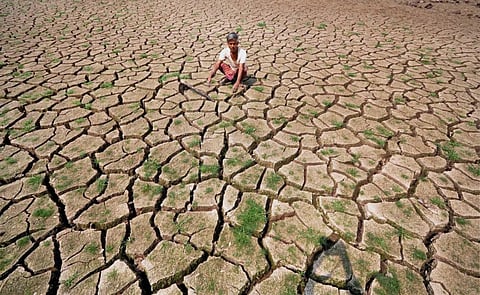From snow to heatwaves: India’s changing climate
Plan to reach net-zero emissions by 2070 is tough as it requires phasing out fossil fuels

No one saw this coming, but heavy snowfall in May in Kashmir is not surprising given recent extreme global weather patterns. Tourists are delighted, but for the locals there is a big worry that the unseasonal snow could damage crops and apple orchards. For the second time this year, scientists have kept a keen eye on the region; a record number of avalanches blamed on global warming have also made the news with two Polish skiers killed and several others rescued from the popular tourist destination of Gulmarg.
Other parts of north India which normally bypass a Spring have been oscillating between switching off the fan or switching on the air conditioner. The National Capital Region has been getting unseasonal showers and misty mornings this year after the global rise in temperatures was also felt in some states. Last year in August, following an intense heatwave, flash floods in Pakistan displaced millions as rainfall three times the 30-year average caused widespread havoc. This unpredictability is the predictability of climate change.
Key to reaching global climate change targets
With the G20 presidency, India has the opportunity and an opening to be a frontrunner on climate action. The World Economic Forum has pointed out that India holds the key to reaching global climate change targets; a report by the Observe Research Foundation (ORF) also adds that India can take the lead by offering a low-carbon growth model that can be adopted by other economies which together account for 80 per cent of greenhouse gas emissions.
But walking the talk is a tightrope. Despite renewable energy targets, in 2020 India had the highest carbon emissions by volume and the country’s coal consumption — coal plants produce a fifth of global greenhouse emissions — rose by 12 per cent the following year. It is expected to peak in the middle of the next decade. As the newly minted most populous nation in the world, the challenges of population density will include growing demands for energy while putting pressure on public health. We only have to look at the devastating impact of pollution.
India has pledged to generate 50 per cent of its electricity from non-fossil fuel by 2030. It sounds acceptable on paper but implementation may be far from easy.
Extreme weather conditions impact the marginalised and those in the unorganised sector the most; it also causes economic damage and loss of life. Last year there were more than 2,200 deaths, the highest in the past three years, and India’s climate action fight is on two fronts — preparedness and anticipation. The global inequity dispute is inevitable but time is running out on the debate of developing vs developed nations. The 2019 Global Climate Risk Index flagged India and South Asia as the most vulnerable. There is a lot to lose, especially if the signals are mixed.
India has pledged to generate 50 per cent of its electricity from non-fossil fuel by 2030. It sounds acceptable on paper but implementation may be far from easy. The country’s pledge to reach net-zero emissions by 2070 is seen as ambitious; meeting the 1.5 or 2-degree Celsius temperature targets requires phasing out all fossil fuels, not just coal. India’s carbon footprint is dictated by domestic necessities, a reason why it abstained from signing the pledge to reduce methane gas emissions at COP26.
How to transition to green energy
Shifting from coal and filthy fuels over the next 30 years will cost India $900 million, reports a Delhi-based think tank. Cleaning up in a phased-out transition to green energy could be one step ahead but without sustainable alternatives for an economy like India, it could also mean two behind.
Keeping net-zero targets in mind, a government report advises banning diesel-powered four-wheeler vehicles in the country by 2027 in cities where the population exceeds one million. The goal is to move to electric vehicles but again ground reality may be different. Big car makers could resist as they have already invested to upgrade to the new BS-VI emission norms that kicked in from April 2020.
Also Read: India: What’s Sharad Pawar’s next move?
Falling back on forest cover for carbon sinks has also been mired in controversy. Experts have questioned the latest methodology used to map forest cover in the country. At the same time, projects like Maharashtra’s controversial Aarey, Mumbai’s green cover where trees have been cut on a large scale to build a metro car shed, show how development that is unplanned in the long term and climate change agenda can still be at odds while time is running out. Neither can afford to be in isolation.
India’s hill stations, increasingly witnessing warmer temperatures, are running out of drinking water. Bypassing environmental regulations has a cost to pay. Look at the Himalayan town of Joshimath, which is sinking with cracks in homes forcing the evacuation of families. When disasters hit — as we are seeing globally — there is no place to flee.
The ask is big, 2023 is projected to be the hottest year globally, and this could only be the beginning.
Sign up for the Daily Briefing
Get the latest news and updates straight to your inbox




